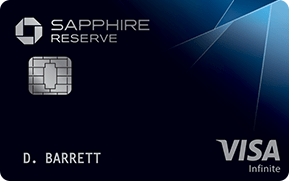
Review: Chase Sapphire Reserve
The Chase Sapphire Reserve has been one of the best travel card from Chase and have outshined its little brother, the Chase Sapphire Preferred, ever since its debut in 2016. However, the card has been feeling the pressure from its competitors and underwent some changes recently with the increase of its annual fee from $450 to $550 in 2020. Does the Chase Sapphire Reserve still hold up to its reputation? Let’s find out.

Earning Rates
Chase Sapphire Reserve earns you Chase Ultimate Rewards points. Here’s what to expect whenever you spend with this card:
- 10x on hotels and car rentals booked through Chase Travel Portal
- 10x on Chase Dining
- 5x on flights booked through Chase Travel Portal
- 3x on travel
- 3x on dining
- 1x on everything else
Compared to the Chase Sapphire Preferred, the Chase Sapphire Reserve does not have a 10% anniversary bonus on base spend and lacks bonus on streaming services and online grocery.
$300 Annual Travel Credit
The $300 annual travel credit has been the iconic benefit of the Chase Sapphire Reserve. The credit applies to anything that codes as travel purchases like flights, hotels, tolls, parking tickets, tours, and so on! The big positive of this benefit is that it doesn’t force you to use a travel portal like the Capital One Venture X or the American Express Platinum Card’s $200 Hotel Credit.
But you may use it on the Chase Travel Portal if you wish, which will work similarly to Expedia. If you’re invested in a hotel loyalty program like Marriott Bonvoy, Hilton Honors, World of Hyatt, or IHG Rewards, then the credits can certainly help you progress towards higher status!
Beware that you won’t receive any points on qualified purchases using the $300 travel credit. You can fully use the credit on a single booking or in smaller chunks until the next anniversary date of opening the card.
Chase Ultimate Rewards Transfer Partners
By having the Chase Sapphire Reserve, you can transfer Chase Ultimate Rewards points to select airline and hotel partners at a 1:1 ratio. You may also combine points from no annual fee earner cards like the Chase Freedom and Ink lineups to further rack up points! The bare minimum to have the ability to transfer your Chase UR points to travel partners is to have either the Chase Sapphire Preferred or the Chase Ink Preferred, in which both boast a $95 annual fee.
Here’s a list of Chase transfer partners:
Airlines
- Aer Lingus AerClub
- Air Canada Aeroplan
- British Airways Executive Club
- Emirates Skywards
- Flying Blue AIR FRANCE KLM
- Iberia Plus
- JetBlue TrueBlue
- Singapore Airlines KrisFlyer
- Southwest Airlines Rapid Rewards
- United MileagePlus
- Virgin Atlantic Flying Club
Hotels
- IHG Rewards Club
- Marriott Bonvoy
- World of Hyatt

50% Bonus on Chase Travel Portal
Each Ultimate Rewards points is worth 50% more when they’re redeemed towards travel on the Chase Travel Portal. While transferring points to travel partners can be worth more, the Travel Portal offers an easier way to offset the cost to your travel where you don’t have to learn intricacies of airline and hotel loyalty programs. You can freely choose to cover the whole bill or partially, which is an advantage compared to transferring to partners as you need to transfer enough points for a redemption.
This is particularly useful for those who aren’t confident or don’t really care for redeeming miles for aspirational things like a Business/First Class airline tickets as learning about airline programs and finding award availability takes time, effort, and flexibility, which not everyone can afford to.
Travel Benefits
Chase Sapphire Preferred offers premium travel benefits despite its generous annual fee like:
- Trip Delay Insurance: if your flight is delayed 6 hours or more, or requiring you to stay overnight, you can be reimbursed up to $500 for the delay (applies to one-way ticket)
- Baggage Insurance: if your bag is lost, you can be reimbursed up to $3000 per trip
- Car rental insurance: Primary collision damage waiver (CDW), which means your credit card’s insurance will go through first before your personal insurance
When it comes to travel protection, the Chase Sapphire Reserve still has one of the best ones out of all the premium travel credit cards.
Other travel benefits include:
- No Foreign Transaction Fee: Useful for international purchases, and being a Visa card means high acceptance rate on places that accept credit cards
- Priority Pass Select & Restaurants: Unlimited lounge access across the globe and eat for free at restaurants in certain airports
- Global Entry/TSA PreCheck/Nexus Credit: Expedited entry and exit on airports. Elect for Global Entry as it will include TSA PreCheck as well. Nexus is basically the Canadian version of Global Entry with additional expedited processing on land crossing and Canadian airports, but you must conduct the interview at US-Canada border or Canadian airport, which may be too restrictive for many.
- Visa Luxury Hotel Collection: As a Visa Infinite card, the Chase Sapphire Reserve has access to the Visa Luxury Hotel Collection. It works similarly to American Express Fine Hotels & Resorts with elite-like benefits included on hotel stays. The nightly rates are on the higher-end though.
Things to Consider Before Applying for Chase Sapphire Reserve
Chase Ultimate Rewards ecosystem is still great for avid travelers or those looking to begin their points & miles journey. But, Chase is notorious for having some of the strictest credit card application rules. Here are the two things you want to consider before applying:
- Chase 5/24 rule: Chase will deny you for applying for 5 or more credit cards within a 24 month period. Read this post to learn more.
- One Chase Sapphire rule: Chase will only allow you to open one Sapphire card per personal account. That means, if you open the Chase Sapphire Preferred and you want the Sapphire Reserve, you’ll either have to downgrade the card to a Freedom or close it. This rule applies vice versa if you have the CSR instead.
- Chase Sapphire 48 month rule: You can only get one signup bonus for the Sapphire lineup once every 48 months. The clock starts after the date you receive your signup bonus. As the CSP consistently has higher signup bonus historically compared to the CSR, it may be wise to signup for the CSP first. Unlike Amex, which has a “once in a lifetime bonus”, it means that you can get the signup bonuses of Chase cards multiple times, but you’ll have to be patient.
Related read: How to Choose: Chase Sapphire Reserve or Preferred in 2022
Conclusion
The Chase Sapphire Reserve has been feeling the pressure from its competitors because of the increase in the annual fee from $450 to $550 while not going through some serious changes like its little brother the Chase Sapphire Preferred. It appears the card is now better suited towards beginners or people who won’t spend time learning about airline programs and optimizing point redemptions on aspirational bookings. The reason is because of the new and high spending multipliers on bookings done on Chase Travel Portal. If that’s the case, then this card will serve you well!
If you only care about having access to Chase Ultimate Rewards travel partners, then I’d argue that the Chase Sapphire Preferred is better for you. With the CSP, you can combine with other premium travel credit cards to get the important benefits like lounge access and Global Entry through cards like the Capital One Venture X or the American Express Marriott Bonvoy Brilliant, which ironically costs less than the Chase Sapphire Reserve, ($490 & $545 vs. $550 respectively) before discounting the benefits.
